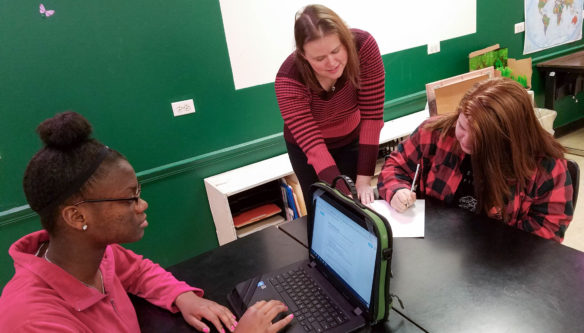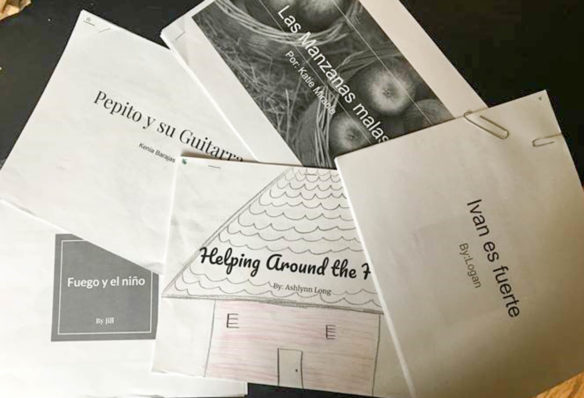
Spanish teacher Rachel Medina works with students Abby Sadler, right, and Jayda Robertson. Medina’s Spanish class learned real-world language skills this year by putting a new spin on traditional fairy tales or writing new ones. Sadler volunteered the idea of sending the books to Norton’s Children’s Clinic in Louisville to fill a need. While there often are books in doctor’s offices, seldom are they in Spanish.
Submitted photo by Kate Boyle
As a world language teacher, presentational writing is one of the standards you teach. While giving a real-world project helps add meaning for students and increases their understanding of what can be a tough lesson, I often had difficulty finding a suitable assignment.
This can be made more difficult as all too often, my students’ audience is just their classmates. And in order to present to a native speaker audience, at times students lack the content knowledge or proficiency skills to do more meaningful tasks. When they do have the ability, the product may already exist. Think about all the things one can already find in Spanish, for example, menus, clothing care instructions and warning labels on prescription bottles.
While working on reading and listening practice with children’s stories this school year, I decided it would be fun for students to write original stories or adapt already existing ones with a new twist. If students chose an existing children’s story they had to adapt or edit it by telling it from another character’s perspective or changing the details. I gave them the examples of the book “The Real Story of the Big Bad Wolf” and the show “Once Upon a Time,” which puts a new spin on traditional fairy tales.
The project would be rigorous, but most importantly, achievable and proficiency-level appropriate for my students. It’s a project that would even work with students at different proficiency levels within the same classroom, a situation that often poses a challenge for world languages teachers.
I presented this storybook project to the students and they took to it. I searched for a place with Spanish-speaking children to donate the new children’s stories to and one of my students, Abby Sadler, volunteered the idea of Norton’s Children’s Clinic in Louisville. This was a perfect fit because so many waiting rooms have books for children to read with their parents, but rarely are there any books in Spanish.
After the students had started writing their pieces, we went through many important stages of writing with editing many drafts. Throughout the process it was beneficial for my students to take all they had learned and mix it together, asking questions, helping each other determine answers and finding ways around what they weren’t sure how to say.

Franklin County’s Rachel Medina found a new way to help her Spanish students with their presentational writing skills. Students were asked to write original children’s stories or adapt an existing one with a new twist.
Submitted photo by Kate Boyle
Finally the day came where the final products were submitted to be sent to Norton’s. I graded each story and it is hands down one of the most enjoyable things I’ve graded. The creativity of many of the one-of-a-kind stories students submitted was phenomenal.
We sent the books over to Norton’s and I checked back a few weeks later. Amy Kovacs, a medical receptionist coordinator at Norton’s, said, “The families were enjoying the books, often laughing while reading them.” I can say it was hard for me to let some of the books go. Some of the students even hand colored the pages.
This project promoted interdisciplinary learning. Crafting the children’s stories helped reinforce the English/language arts production and distribution of writing standards. Students produced clear and coherent writing appropriate to the task, purpose and audience (writing standard 4), and they strengthened their stories by revising and editing what was most significant for the specific purpose and audience (writing standard 5). The project also helped strengthen language skills in Spanish.
Most importantly, this project gave students a sense of pride in their accomplishment by creating a finished product that someone else actually would be reading and enjoying. It gave them a sense of community by providing something not regularly found in waiting rooms.
Rachel Medina is a Spanish teacher at Western Hills High School and Bondurant Middle School (Franklin County).




Leave A Comment